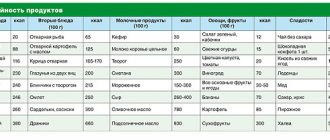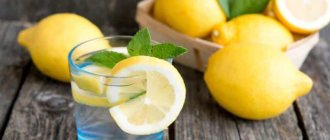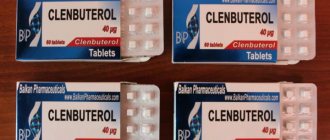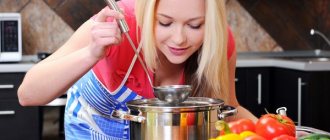- The essence of the diet
- Principles
- Calorie calculation
- What is possible and what is not
- Rules for creating a menu
- Recommendations
- Contraindications
Diets are always associated with dietary restrictions and prohibitions. Daily calorie counting is a method of losing weight, in which it is not prohibited to eat your favorite foods, but you must follow their strict dosage. Thanks to the established calorie norm, you can either lose unwanted pounds or simply maintain your weight at the optimal level.
The essence of the diet
The principle of losing weight on a calorie diet is that during the day the body should receive fewer calories than it burns. Thus, energy will begin to be wasted from fat deposits.
This method is considered the safest, since the kilograms will disappear slowly.
“Nothing tastes better than feeling thin” Kate Moss
Optimal food
To get only benefits from food, you need to buy natural products. A woman or man who is losing or gaining weight needs the following nutrients:
- Proteins (lean meat, fish, eggs, legumes) are involved in the construction of new tissue, support recovery processes, and help increase muscle fiber. Proteins should take up 1/3 of the daily diet.
- Complex carbohydrates (buckwheat, oatmeal, millet, chickpeas, peas, bran) provide energy and activate brain activity. This group of nutrients should make up ½ of the daily menu.
- Unrefined fats (eggs, avocados, walnuts, almonds, fatty fish, olive oil) are also necessary for the body, but their amount should not exceed 1 g/1 kg of total weight.
- Fiber (bran, grains, vegetables, fruits) improves digestion.
- Vitamins strengthen the immune system and have a beneficial effect on the functionality of the body.
- Minerals are necessary for the construction of tissues, water metabolism, and enzymatic processes.
Expert opinion
Evgeniy Kislitsa
Practicing surgeon. Certified massage master. Two-time vice-champion and heavyweight champion of regional kettlebell lifting competitions.
Fiber has a beneficial effect on the functioning of the gastrointestinal tract, as it stimulates rhythmic contractions of the intestinal wall (peristalsis) and allows physiological control of the balance of intestinal microflora. The latter is necessary for normal digestion and the functioning of the immune system (a significant proportion of immunity is formed due to appropriate reactions in the intestinal cavity). Minerals, in addition to these functions, ensure the transmission of nerve impulses between cells. Such reactions ensure the functioning of all organs in the body. The role of minerals is especially important for the normal functioning of the heart (heart rate). It is also due to sodium that the filtration apparatus of the kidneys functions, due to which urine is formed and excreted from the body.
Interesting! Bean products, in addition to containing complex carbohydrates, are rich in plant proteins, so they can be used not only as a source of essential carbohydrates, but also proteins.
In addition, you should supplement your diet with foods rich in organic acids, tannins, flavonoids, etc.
For weight loss
Properly selected products will help a person speed up fat burning:
- Tomatoes, cucumbers, white fish, oranges, grapefruits contain few calories.
- Oatmeal, grade A pasta, beans, wholemeal bread, and apples will satisfy your hunger.
- Milk (0.1%), lentils, salad, berries do not increase glucose levels in the body.
- Cottage cheese (low fat), chicken offal, seafood, and tuna contain little fat.
- Olive oil, flax oil, almonds, and avocado contain fatty acids.
- Apples, carrots, paprika, celery, sugar-free dairy desserts, fruit purees, and berries have a pleasant taste and texture. In addition, they are rich in vitamin and mineral compounds, improve the functioning of the gastrointestinal tract and contain few calories.
- Lingonberries, berry fruit drinks, and celery have a diuretic effect, so they not only allow you to remove excess fluid from the body, but also have a beneficial effect on kidney function.
- Bananas, dietary milk products, bread, nuts, and dried fruits are used as a snack.
- Cheese, low-fat cottage cheese, dietary fish, egg whites, and beans will speed up weight loss and preserve muscle mass.
And dark chocolate (from 75%), dates, and nuts provoke the production of the joy hormone.
Important! Those who have diseases of the gastrointestinal tract should not get carried away with dark chocolate. After all, it irritates the mucous membrane of the intestines and stomach, which can lead to exacerbation of chronic diseases of the digestive organs.
Nutrition for weight gain
To gain weight faster, you need to increase the amount of protein and carbohydrate foods in the menu. Sources of protein: seafood, dietary meat, fish, milk, dairy products. Chicken is ideal for this purpose; it is quickly digested, so it can provide muscle tissue with the proteins necessary for its growth and recovery faster than other types of meat.
To recharge your energy, it is recommended to eat cereals, vegetables, and fruits. And crispbreads and bran bread contain healthy fiber.
Don't forget about fats: olive, sesame oil, seeds, nuts, etc.
This is interesting! To speed up the process of gaining muscle mass, it is recommended to take sports nutrition, vitamins, and minerals.
Expert opinion
Evgeniy Kislitsa
Practicing surgeon. Certified massage master. Two-time vice-champion and heavyweight champion of regional kettlebell lifting competitions.
To accelerate muscle gain and increase strength, it is recommended to use protein, creatine, BCAA (a complex of essential amino acids), amino acid complexes (including essential and non-essential). Protein (shakes, bars, etc.) allows you to deliver the necessary protein to the cells within 20-30 minutes. It is recommended to use protein isolate. It contains more protein and fewer calories by reducing the amount of carbohydrates. Protein concentrate is more suitable for those who are less calorie conscious or who are dieting to gain calories from concentrated protein supplements. However, the cost of protein isolate is higher than that of concentrate. BCAA allows you to provide the body with amino acids, which play a primary role in the restoration and growth of muscle cells. Moreover, this supplement contains virtually no calories. However, the effectiveness of its use is still disputed among professionals. The amino acid complex represents proteins split into monomers (structural units). This allows them to be absorbed by the body faster and does not waste time and energy breaking down proteins from protein supplements. However, the cost of an amino acid complex is often not inferior to protein. Creatine is a sports supplement that accelerates energy metabolism in muscle tissue and supplies it with energy. But creatine causes muscles to retain water, which, on the one hand, increases their volume, and on the other, leads to unnecessary weight gain. However, it is necessary to take creatine strictly for a certain time, and already 1-2 weeks after stopping its use, the liquid leaves the tissues. But after stopping taking the sports supplement, there is a decrease in strength and overall endurance. This is observed until the body gets used to “working” without the use of creatine from the outside.
Principles
To achieve maximum results, the following principles must be observed:
- Diet variety
- Predominance of protein foods
- Compliance with the daily intake of fats (80 g) and carbohydrates (100 g)
- Limiting simple carbohydrates
- Avoiding sweet drinks and strong alcohol
- Reducing salt intake
- Drinking large quantities of water (at least 1500 ml per day)
- Small meals 5-6 times a day
Calorie calculation
The opinions of nutritionists on this issue are divided: some are convinced that the calculation is individual for each person, others offer average options.
By formulas
The most common weight loss options are based on the number of calories per day, which depend on the height, weight and age of the person wishing to lose weight. There are several formulas for calculating optimal calorie content:
Option #1
(1.8 • height, cm) + 655 + (9.6 • weight, kg) – (4.7 • age, years)
The resulting figure is the amount of energy required to maintain the body's systems.
The second stage of calculations will be to determine the physical activity coefficient. You can determine it by assessing your lifestyle:
- Passive lifestyle (sedentary) – 1.2
- Low-intensity activity (physical exercise 1-2 times a week, walking) – 1.4
- Moderate level activity (exertion more than 3 times a week) – 1.5
- High-level activity (work on the legs, systematic sports) – 1.7
- Excessive activity (heavy daily long-term exercise) – 1.9
The number after the first stage is multiplied by the selected coefficient.
The result obtained is weight stability. In order for weight to begin to decrease, you need to subtract another 400-500 kcal.
Option No. 2
30 • (height, cm – 105)
The resulting number is to save weight. To reduce it, we take away another 300-600 kcal, depending on the activity of our lifestyle.
On average
Weight loss methods from this group do not imply individual calculations, but consist of following a diet of a certain calorie content.
These include diets of 800, 1000, 1200 calories per day and other options.
Counting calories in ready meals to lose weight
During the calculation, it should be taken into account that the calorie content of water, salt and spices is zero. However, due to water, only the weight of the dish increases, so the caloric value will not change, even taking into account the change in its weight.
Important! When choosing a diet plan for weight loss, write down the calories and proportions of all recipe components in a notebook so as not to make calculations for ready-made dishes several times.
When calculating the nutritional value of food, use the following formulas:
- A gram = B kcal.
- 100 grams = X kcal.
A – weight, B – calorie content.
Calculating calories is not difficult; to do this, 2 numerical values located diagonally need to be multiplied by each other, and then divided by the number located diagonally (X). Based on this, the nutritional value of 100 g of a dish is equal to B multiplied by 100/A.
For example, you need to calculate the calorie content of rice porridge. There are 330 kcal per 100 g of cereal. If you need 300 g of rice, then its nutritional value is 990 kcal. This indicator does not change with salt and water. The total mass of the dish is 900 g. Calculation: 900 x 100: 900 = 110 kcal/100 g.
Calculating the calorie content of soup is more difficult, since it contains many components. First you need to weigh the products separately:
- meat – 300 g;
- carrots – 50 g;
- garlic – 30 g;
- potatoes – 700 g;
- greens – about 10 g;
- pepper – 10 g.
Total mass - 1100 g. Using a scale or table, you need to calculate the calorie content of each component, let's say yours is 1198 kcal. The weight of the soup decreased to 1050 g, as part of the water boiled away, but the nutritional value did not change.
We calculate the number of calories as follows: 100 g of a dish contains X calories, therefore: 1198 x 100: 1050 = 114 kcal.
Fact! Modern calorie counters and corresponding tables for the most part contain already calculated calorie content for many dishes, including soups, so you can use them to make it easier to calculate the daily calorie content of food.
To make your life easier, you can use calculators that calculate the energy value of dishes in an instant. This is the simplest option for calculating the content of calories and dietary fat.
What is possible and what is not
A low-calorie diet is not strict regarding the names of products. But still there are both more and less suitable foods.
Recommended Products
Ideally, the diet should include:
- Buckwheat and pearl barley porridge
- Lean meat, poultry and fish
- Cutlets, steamed meatballs
- Egg white
- Mushrooms
- Vegetable soups with light broth
- Rye bread, bran bread or wholemeal bread
- Vegetables, raw or steamed
- Low calorie fruits (apples, oranges, etc.)
- Unsweetened tea, coffee, fresh
- Fermented milk products (kefir, yogurt, cheeses)
Unwanted Products
If you wish, you can create your own diet and count calories. But it is important to remember that there are prohibited foods. If there are any, then the weight loss process will be slowed down. Among these:
- Preservation and salinity
- Smoked meats
- Sausages
- Fatty meat, poultry and fish
- Potatoes in any form
- Egg yolk
- Nuts
- Pasta
- Baking
- White bread
- Margarine, butter
- Cocoa
- High-calorie fruits and dried fruits
- Sweets (except marshmallows and marmalade)
- Sauces
You can create a menu by combining products taking into account their energy value and portion size.
Calorie content of individual products
For the convenience of calculating acceptable food combinations, you can use the table of caloric content of permitted foods.
Calorie content is indicated for the product in its raw form.
Calorie content of dishes
It is impossible to create a high-quality menu for every day without knowing the calorie content of already prepared dishes.
Calorie table for ready meals:
On a note. For convenience, it is better to print the tables and keep them for quick access.
Diet for weight loss
No matter how much newfangled weight loss products are advertised, you should not rely on their miraculous powers. Miracles must be created through your own actions. The basis of losing weight is unshakable - proper nutrition and physical activity. All this can be organized at home and fight extra pounds on your own.
The path to losing excess weight is long and difficult; it is different for everyone, so it is individual. There are no perfect options when it comes to losing weight. The main task of those losing weight is to have the right psychological attitude, clearly see the goal and not give in to difficulties, stock up on endurance and a good mood. A properly organized process of losing weight can become an exciting learning experience, self-development, and self-education for everyone.
To create a diet, a specific goal is important - how many kilograms you need to lose, and what parameters you need to achieve. Body weight is not the only indicator that needs to be monitored. The volumes of the chest, waist, and hips are no less important. You need to take all the necessary measurements and record them, you can take a photo. With regular exercise, adipose tissue disappears and muscles begin to grow, so at a certain stage the mass may increase or remain unchanged. Reducing volumes is a more indicative and significant result.
Nutritionists advise everyone starting healthy weight loss to keep a food diary and plan all meals. To switch to proper nutrition, consider the general rules. Necessary:
- Determine the number of meals and portion sizes.
- Create a diet plan and strictly adhere to it.
- Leave enough protein in your diet. This is important for maintaining muscle health. They are the main fat burners; loss of muscle mass should not be allowed. Protein foods help maintain healthy skin, which should maintain firmness and elasticity while losing weight.
- Organize a drinking regime (about 2 liters of clean water).
- Strictly exclude sweet pastries and any other junk food from your diet while losing weight.
- Choose healthy, healthy food that is tasty and easy to enjoy. Understanding how much vital energy and benefits it will bring to the body will make eating healthy food a good habit, a way of life.
- Weighing and measuring volumes will help you monitor the effectiveness of your weight loss program. This procedure should be carried out once a week. There is no need to be nervous and worry again. It is better to rejoice at even the smallest victory, to praise yourself for your perseverance and determination.
It is necessary to part with some foods and dishes for a while, and then minimize their consumption in the future. Foods that interfere with weight loss:
- salt, sugar;
- white bread, muesli;
- White rice;
- confectionery;
- mayonnaise, margarine, ketchup, sauces;
- sausages, canned food, any semi-finished products;
- hard cheese (fat);
- sweet fermented milk products;
- meat broths;
- fast food;
- carbonated drinks;
- packaged fruit juices;
- alcohol.
Proper nutrition
A person can obtain nutrients exclusively from food. They are necessary to maintain the vital functions and vitality of the body; it draws energy from them and recovers from them. How to start eating right? You will need to plan and analyze your diet, schedule your meals, and keep a diary. What information to analyze in the diary:
- Write down the times of all meals and the meal “menu” (even if it’s crackers with tea). It is so easy to determine how many times and what food was consumed.
- Record the amount of food eaten (approximate weight of dishes or “goodies”).
- Reason for eating food. Everything is very clear with main meals and snacks in between. What about the other times?
- Calculate the calorie content of foods eaten per day. You can find calorie counters on online websites. They make it easy to control the calorie content of your daily menu.
Analyzing your diet for several days will help you decide on a list of healthy foods. The transition to proper nutrition should be gradual. Replace fried with stewed or baked in the oven, sweet with fruit, white flour bread with bran or whole grain. Eating for weight loss does not allow for strong feelings of hunger. This is stress for the body; it will begin to store rather than give away. A glass of kefir at night will not do any harm if your bedtime is later. And for those with a sweet tooth, you can sometimes allow a spoonful of honey or a slice of dark chocolate. A positive attitude is more important.
Proper (or rational) nutrition involves only three main tasks. They must be taken into account and implemented:
- Daily caloric intake must correspond to energy expenditure.
- Nutrition should be varied and balanced to meet the body's daily needs for proteins, fats, carbohydrates, microelements and vitamins.
- It is important to follow a diet. This improves digestion, absorption of what you eat, and improves metabolism.
Diets for weight loss at home
Weight correction techniques have a rich arsenal of diets. None of them guarantee 100% results. Any diet means restrictions, a violation of the principles of rational nutrition, and stress. Every organism is individual, and it is difficult to predict its reaction to a stressful situation. Each diet has pros, cons, and contraindications. Analysis of several popular diets for quickly gaining a slim figure:
- Protein. The basis of the diet is proteins, and fats and carbohydrates are kept to a minimum. One of the most effective. Allows you to quickly lose weight by digesting proteins, the body burns calories. There is no painful hunger. It has a lot of contraindications. A large amount of protein in food is an additional burden on the stomach, liver and kidneys, increases cholesterol levels, problems with blood pressure, and possible joint diseases.
- Extreme. The calorie content of food is reduced as much as possible. The diet lasts no more than three days. Weight loss happens quickly. The menu requires strict adherence to the chosen diet; it is not recommended to consume additional liquid, as this provokes an even stronger feeling of hunger. Weight loss is largely due to fluid loss rather than fat breakdown. Extreme diets are carried out no more than once a month.
- Drinking. An interesting technique not only for losing weight, but also for cleansing the body. For 30 days a person consumes only liquid foods. In the first 10 days, the gastrointestinal tract is cleansed, and in the next 10 – the circulatory, respiratory and urinary systems. The last 10 days help cleanse the cells of the entire body from waste and toxins. Weight loss – up to 15 kg. Going without solid food for a long time can lead to digestive problems.
- Mono-diets. They are easy to implement and do not require large budget expenditures. You need to choose one of the permitted foods, which you can eat in any quantity. The weight will decrease. Any mono-diet causes metabolic disorders, because the human body is adapted to digest a variety of foods. With its long-term use, part of the digestive glands atrophies, which leads to disruption of food absorption. Side effects will be minimal if the diet is short and a product suitable for a particular organism is selected.
Set of products for weight loss
With properly organized nutrition, the body receives all the necessary organic substances (or nutrients). It is important to maintain their balance, calculate the quantity and calorie content. A proper diet for weight loss should include:
- Squirrels. These are the basic substances. They regulate metabolic processes and the body is built from them. Lean meat, fish, eggs, cottage cheese and other fermented milk products are protein foods.
- Fats. Their number needs to be reduced, but not completely eliminated. They are important for building cells and are the basis for the formation of many hormones. Omega 3, 6, 9 are healthy fats. There are many of them in sea fish, seafood, and olive oil.
- Carbohydrates. Source of energy. To lose weight, simple carbohydrates (sweets, white pastries, potatoes) need to be replaced with complex ones (cereals, dark flour products).
It is important to include fresh vegetables and fruits in your diet. Spices and drinks are good for weight loss. List of natural fat burners:
- celery;
- all types of cabbage;
- grapefruits, pineapples, apples;
- figs;
- nuts;
- cinnamon;
- ginger;
- green tea;
- red wine.
Nutrition for weight loss. How to create a menu for the day?
Rules for creating a menu
One of the principles of the effectiveness of the diet is to eat small portions, but often. It would be optimal to split the daily diet into five times. An important point is the correct percentage of calories between meals.
Regardless of whether the calculation is based on 1000 calories per day or according to any other option, the correct ratio is considered to be:
- 25% – breakfast
- 10% – second breakfast
- 35% – lunch
- 10% – afternoon snack
- 20% – dinner
It is advisable to include in different combinations at each meal:
- For breakfast: porridge, fruit, eggs, cottage cheese, tea or coffee
- For second breakfast: fermented milk products, fruits
- For lunch: broths, soups, meat, bread, vegetables, fish, salads
- Afternoon snack: dairy products, fruits
- For dinner: meat, vegetables, fish, salads, tea
If you have a desire to eat something from the list of not recommended foods, then you don’t have to deny yourself this. The main rule is not to go beyond the daily energy value.
Sample menu for calorie counting
You can create a menu at your own discretion. The main thing is to keep within a certain energy value of the daily diet. An approximate menu for proper nutrition with calorie counting for weight loss may look like this:
- A portion of oatmeal on water, a slice of cheese;
- Yogurt without sugar, unsweetened fruit;
- A portion of buckwheat porridge, a steamed cutlet, a salad with vegetable oil;
- A small piece of cottage cheese casserole;
- Omelet with spinach and vegetables, a glass of kefir.
It is important to constantly add variety to your diet. In this way, the risk of failure will be reduced.
Be sure to read: Fasting as a way to lose weight and improve your body health
Recommendations
A person who decides to lose weight in calories, first of all, must decide on the value of the diet. The safest option is considered to be an individual calculation of the daily requirement. This is due to the fact that the personal characteristics of a particular person are taken into account.
If you like diets with a set calorie content, it is important to consider the following points:
- To lose weight without stress, it is better to alternate a week with critical caloric intake with a week of weight stabilization.
- It is not recommended to immediately set the bar low (800 calorie diet), as this can lead to exhaustion.
- Without harm to health, it is better not to lower the bar below 1200 kcal.
- As an exception, you can vary your daily calorie intake based on physical activity. If the day is spent passively, then you can do a fasting day and reduce the value of the diet. If the day is physically difficult, then it is appropriate to increase the calorie content to 1400 or even 2000 kcal.
- It is not advisable to be on a low-calorie diet for a long time (more than a month).
- The exit should be smooth, gradually increasing the daily calorie content by 300-500 kcal.
- Ideally, the weekly menu should include a variety of foods to get all the vitamins and minerals.
The most correct decision on choosing both the diet itself and calculating the optimal daily caloric intake is consultation with specialists. A gastroenterologist will indicate whether there are any contraindications, and a nutritionist will competently describe the nutritional scenario.
Diet for weight loss (with an example menu for 1600 kcal)
Diet is extremely important for losing weight. It helps you become disciplined and selective when choosing foods. The main condition is that this mode is comfortable for you. Why do you think people quit strict diets? Because they are inconvenient. An adequate calorie deficit and a comfortable diet consisting of your favorite healthy foods are the most successful weight loss strategy.
How often should you eat?
The distribution of foods throughout the day should be convenient for you, but the calorie deficit must be maintained. The optimal period of time between meals is 3-4 hours.
If you have a lot of excess weight and your calorie deficit exceeds 1500 kcal, then the best option would be split meals 5-6 times a day. If you are not overweight and your caloric deficit is below 1500 calories, then consider eating 3-4 times a day.
People who are heavier often have increased insulin secretion and difficulty controlling their appetite and will benefit more from smaller meals. It will allow you to divide your daily caloric intake into a large number of meals, thereby maintaining satiety, normal sugar levels and avoiding overeating. But splitting 1300-1400 calories into 5-6 meals and eating in tiny portions will not be easy.
What should breakfast be like?
Breakfast sets the tone for the whole day. After a long period of overnight hunger, the body needs nutrients. Having the right breakfast helps control your appetite throughout the day. At night, the body reduces insulin secretion, and now imagine what will happen if you eat a large portion of carbohydrates in the morning - a high glycemic load, a rapid rise in blood sugar, a surge in insulin. The slower carbohydrates are digested, the smaller the sugar spike will be. Protein, fats and fiber help slow down the absorption of carbohydrates.
Therefore, protein must be present in breakfast - at least 20 g. This is also due to the fact that the last meal of protein food was yesterday. When the body does not receive “building material” for a long time, it begins to use internal reserves - to destroy its own muscles.
A complete breakfast can be protein-carbohydrate or protein-fat. A protein-carbohydrate breakfast is suitable for people who are most active in the first half of the day. They work in mobile work or train. A protein-fat breakfast is suitable for people who are not used to eating in the morning, follow a low-carbohydrate diet, or are inactive in the morning.
Examples of a successful breakfast
Protein-carbohydrate breakfast:
- Oatmeal with water and raisins, an omelette made from one whole egg and two whites;
- Buckwheat porridge on water with chicken breast and vegetables.
Protein-fat breakfast:
- Fried egg of two eggs and vegetable salad with butter;
- Cottage cheese with berries and nuts.
10 minutes after breakfast you need to take vitamins and a fish oil supplement.
What can you eat for a snack?
The purpose of snacking is to maintain moderate blood sugar levels and avoid overeating and discomfort. It should include proteins and fiber-rich carbohydrates.
Examples of a successful snack:
- Whole grain bread with cream cheese;
- Vegetable salad with chicken breast and low-fat cheese;
- Cottage cheese with berries or fruit;
- Vegetable sticks and Greek yogurt sauce.
What should lunch be like?
Lunch is the largest meal of the day. By lunchtime you've already worked up an appetite, so the main task is not to overeat and ensure long-term satiety. For it, choose complex carbohydrates, proteins and vegetables. If you eat first courses, then consider the amount of carbohydrates in them. For example, pureed pea soup contains much more carbohydrates than light vegetable soup without potatoes. There is no need to add additional carbohydrates to it. Aim for 20-30 g of protein, 10-15 g of fat and 30-40 g of carbohydrates. Remember, you must fit within the framework of your balanced KBZHU.
Examples of a successful lunch
With the first course:
- Pea soup, skinless chicken drumstick, fresh vegetable salad with butter;
- Borscht with potatoes, toast made from bran or whole grain bread, vegetable stew with lean meat.
Without first course:
- Brown rice with chicken and vegetables;
- Buckwheat porridge with baked lean fish and vegetable salad;
- Durum wheat pasta with lean meat and fresh vegetables.
Nutrition before and after training
Most people exercise after work, but not everyone has time to eat before training and make the big mistake of going to the gym hungry. Fatigue accumulated during the day and low blood sugar levels due to a long period without food will not allow you to carry out an intensive exercise. If you are doing strength training in the gym or with barbells and dumbbells at home, then you need to eat 1.5 hours or have a light snack 30 minutes before it starts. If you're doing a cardio workout or doing a video workout at home, you don't need to have an extra snack before your workout.
Examples of pre-workout meals
If you can eat normally in 1.5 hours:
- Baked potatoes and baked lean fish with vegetables;
- Sandwich made from whole grain or bran bread with chicken fillet and herbs.
If you can have a snack in 30-40 minutes:
- Sweet and sour fruit (apple, orange, pineapple, pear or berries) and Greek yogurt;
- Sweet and sour fruit and a portion of protein.
If you're hungry before a cardio workout, you can snack on fast-digesting proteins 30 minutes before:
- Serving of whey protein;
- Egg whites.
After training, you need to eat within an hour. If you are going straight home, then just having dinner is enough, but if after training you have some meetings and the next meal will not take place soon, then you should drink a portion of protein. You will satisfy physiological hunger and create favorable conditions for muscle recovery.
What should dinner be like?
The ideal dinner is light, since most people are inactive in the evenings and spend them at home. An exception may be people who have a light dinner that makes them wake up at night and sweep away the entire contents of the refrigerator. For such people, nutritionists recommend having a light breakfast and a hearty dinner within the daily caloric intake. The composition of a standard dinner is protein and carbohydrates from vegetables.
Examples of a successful dinner
- Baked fish of moderate fat content and blanched vegetables;
- Stewed liver and stewed vegetables with butter;
- Omelette and vegetable salad.
What can you eat before bed?
The last meal should take place no later than two hours before bedtime. Choose light, protein-rich foods. Fermented milk products are ideal for a late snack; they will take care of your muscles and intestinal microflora during night hunger.
Examples of a successful late-night snack
- A glass of kefir 1%;
- A glass of natural unsweetened yogurt 1-2%;
- A portion of low-fat cottage cheese.
You can add a sweetener based on stevia, vanilla, cocoa, bran or fiber to kefir, cottage cheese or yogurt, but it is better to abstain from fruits, honey and sugar.
Example of a 1500-1600 calorie diet
Let's look at what a 1500 calorie diet might look like. You can adjust it according to your caloric and nutritional needs.
- Breakfast: 50 g oatmeal, 15 g raisins, omelet from 1 whole egg and 2 whites, 50 g skim milk.
- Snack: apple, 100 g cottage cheese 5%.
- Lunch: 150 g of buckwheat porridge, one skinless chicken drumstick, 120 g of fresh vegetable salad with butter.
- Before training: whole grain bread 40 g, chicken breast 85 g, non-starchy vegetables and herbs.
- Dinner: 120 g lean fish, 150 g stewed cabbage with butter.
- Late snack: a glass of kefir 1%.
Total: 1568 calories, 131 g protein, 56 g fat, 142 g carbohydrates.
Please note that a small portion of protein is present in each meal. Protein has a high thermic effect - during digestion you spend up to 20% of its calorie content. It slows down the absorption of carbohydrates, prevents spikes in blood sugar and helps control the feeling of fullness.
You can adjust examples of meals and the final menu to suit your needs in your Personal Account. All you have to do is choose your favorite healthy foods and appropriate portion sizes.
For those who read the article to the end - a bonus - examples of diets according to the KBJU.
Author: Ekaterina G., nutritionist, fitness blogger (especially for) Copying this article in whole or in part is prohibited.











